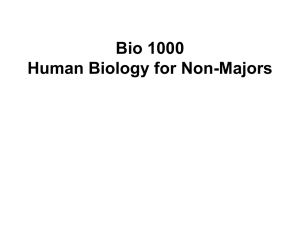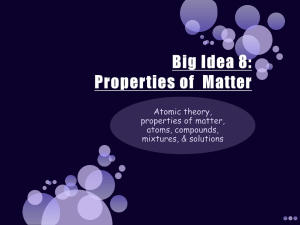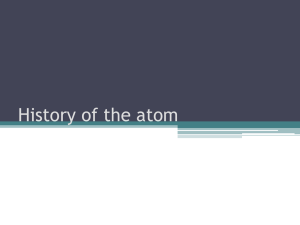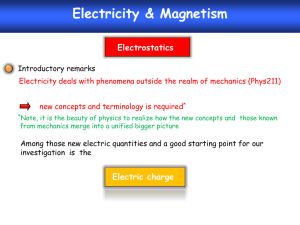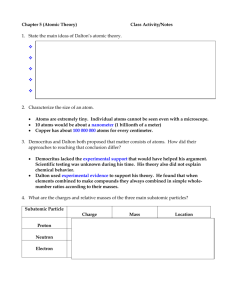Science Notes on Atomic Theory
advertisement
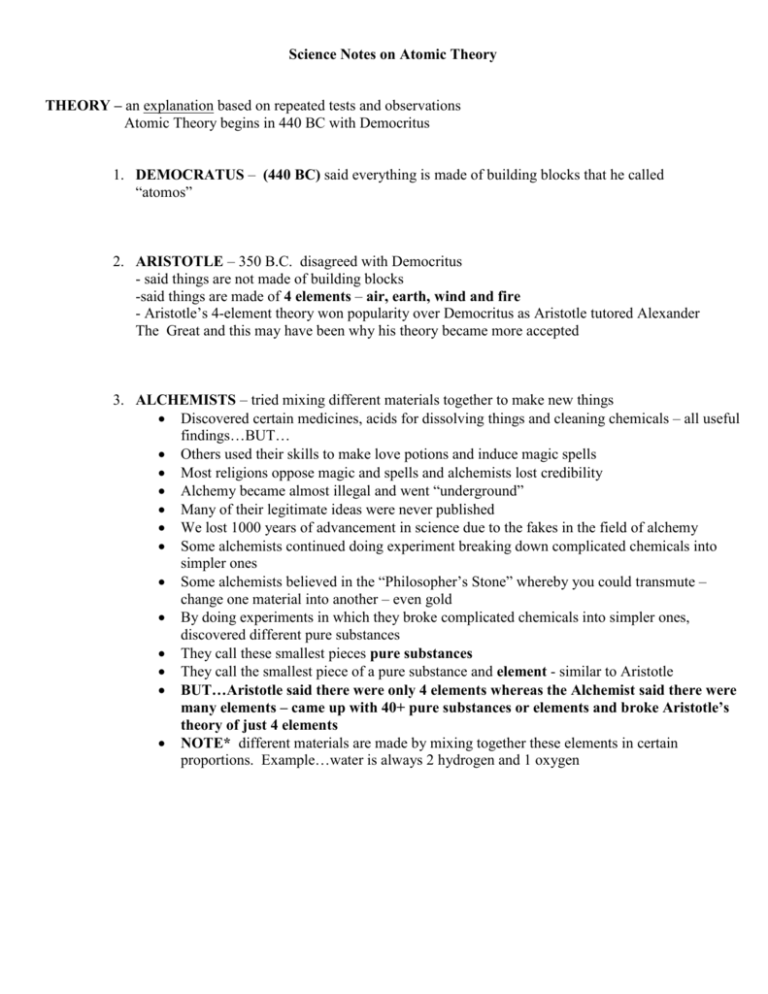
Science Notes on Atomic Theory THEORY – an explanation based on repeated tests and observations Atomic Theory begins in 440 BC with Democritus 1. DEMOCRATUS – (440 BC) said everything is made of building blocks that he called “atomos” 2. ARISTOTLE – 350 B.C. disagreed with Democritus - said things are not made of building blocks -said things are made of 4 elements – air, earth, wind and fire - Aristotle’s 4-element theory won popularity over Democritus as Aristotle tutored Alexander The Great and this may have been why his theory became more accepted 3. ALCHEMISTS – tried mixing different materials together to make new things Discovered certain medicines, acids for dissolving things and cleaning chemicals – all useful findings…BUT… Others used their skills to make love potions and induce magic spells Most religions oppose magic and spells and alchemists lost credibility Alchemy became almost illegal and went “underground” Many of their legitimate ideas were never published We lost 1000 years of advancement in science due to the fakes in the field of alchemy Some alchemists continued doing experiment breaking down complicated chemicals into simpler ones Some alchemists believed in the “Philosopher’s Stone” whereby you could transmute – change one material into another – even gold By doing experiments in which they broke complicated chemicals into simpler ones, discovered different pure substances They call these smallest pieces pure substances They call the smallest piece of a pure substance and element - similar to Aristotle BUT…Aristotle said there were only 4 elements whereas the Alchemist said there were many elements – came up with 40+ pure substances or elements and broke Aristotle’s theory of just 4 elements NOTE* different materials are made by mixing together these elements in certain proportions. Example…water is always 2 hydrogen and 1 oxygen 4. 5. JOHN DALTON – 1803 An English school teacher Did experiments with elements and said each element is a different kind of building block Brought back Democritus’ atomos theory Dalton called his building blocks “atoms” to credit Democritus Dalton said that atoms combine in certain ratios to make new things Father of Modern Chemistry Atoms are like solid billiard balls that stick together or bounce off each other – have only one part Came up with 3 conclusions 1. Atoms of the same element are the same - and different elements have different atoms 2. Atoms are the smallest particle and cannot be broken into smaller units 3. Atoms join in certain proportions to make new substances J J THOMSON – England……..JJT with the CRT Science at this time was taking off; all kinds of new technology Thomson used a Cathode Ray Tube –CRT and decided there are 2 parts to an atom – a positive and a negative part CRT is an invisible ray gun Thomson said the atom is mostly a positive space with little negative chunks called electrons Called his model the “Plum Pudding Model” or we can think of it as the “Chocolate Chip Ice Cream Model” 6. ERNIE RUTHERFORD – 1909….. think Rutherford and R adiation J J Thomson’s student Did experiment with radiation Shot radiation bullets through a thin sheet of gold surrounded by a screen The bullets should have passed straight through the gold sheet and did for the most part…BUT…every so often the bullet would ricochet and be deflected to another part of the screen This could only happen if the radiation beam hit something solid…So… Rutherford decided the atom was mostly empty space but had a positive center – the nucleus He discovered the nucleus of the atom Said there were negative pieces orbiting the positive center…like planets revolving around the sun His model became known as the solar system model 7. NEIL BOHRS – 1913 Agreed with J J and Ernie that there is a positive space and particles that circulate…BUT… the particles change paths (jump from one energy level to another) and their orbits are NOT circular Instead he said the negative particles travelled in paths or energy levels His model has the nucleus in the center and electrons orbiting the nucleus in levels Bohr’s model became known as the Energy Level Model 8. SCHRODINGER & HEISENBERG – came up with Modern Theory 9. They updated the Neils Bohr Energy Level Model They said the atom does have a positive center (nucleus) with negative particles (Electrons) the surround the nucleus in an electron cloud Said the particles move so fast that we never know just where any one of them will be at any time…we can only predict where we think they will be and that these particles switch levels and distances from the nucleus This model is the one we currently use and it is called the Electron Cloud Model The Electron Cloud Model has atoms with a solid center and a foggy area with negative particles throughout it JAMES CHANWICK - 1932 …Discovered the NEUTRON By 1932 we already know that there were 2 parts to an atom – the proton – the positive center and the electron – the negative particles orbiting the center Chadwick understood what kept the electrons orbiting the nucleus (positive center) and that was that OPPOSITES ATTRACT What he didn’t get was what kept the protons together inside the nucleus because LIKE CHARGES REPEL (move away from each other) By studying the weights of atoms. He found that the protons in the nucleus were held in place by another particle called a NEUTRON For every proton there was a neutron that separated it from another proton Notes on Atomic Structure There are three parts of an atom that we will discuss: 1. Protons – a large particle located inside the nucleus of an atom. They have a positive charge 2. Electron – a tiny particle located outside the nucleus in orbitals or shells. They have a negative charge 3. Neutron – a large particle located inside the nucleus with the protons. They have no charge There are more than 3 sub-atomic particles, but we will discuss just these three for now. However, we have found 12 parts to the atom – 6 leptons and 6 quarks Protons and Neutrons can be broken into smaller parts called quarks Electrons can be broken into smaller parts called leptons Different kinds of atoms have different numbers of protons EX….Hydrogen has 1 proton Helium has 2 protons Lithium has 3 protons Gold has 79 protons The Most Recent Theories….. 1960s scientists built “atom smashers” which accelerate protons at high speeds then smash tem together Found that protons smashed into smaller pieces proving that they were not the smallest piece of matter They called these smaller pieces of protons and neutrons “quarks” Quarks are categorized into up/down, charm/strange and top/bottom Other scientists disagree with quark theory and go with “String Theory”. String Theory states that the basic building blocks of matter, quarks and electrons are really one dimensional vibrating strings that are embedded within an eleven dimensional space




